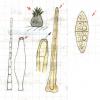
02-12-2025 18:59
This pair of ascos 2.5cm across were on recently b

02-12-2025 19:25
Buckwheat PeteHello, can anyone identify this hairy fungus growi

30-11-2025 12:53
 Edvin Johannesen
Edvin Johannesen
White short-stipitate apothecia found on thin twig

30-11-2025 10:47
 William Slosse
William Slosse
I recently found a collection of small Peziza sp.

27-11-2025 12:01
Thomas Læssøehttps://svampe.databasen.org/observations/10496727

27-11-2025 11:46
Thomas Læssøehttps://svampe.databasen.org/observations/10493918
Setose pyrenomycetes
Hans-Otto Baral,
08-05-2011 21:42
 I was asked by a colleaque to post here this pyrenomycete which he cannot identify: Zotto Pyrenomycet spec. (setose) Habitat: Populus-stump, Perithecia superficial in groups, pyriform, dark brown-black, thick-walled, soft, textura angularis, at the base with redbrown hyphae, setose at the upper part; setae erect, stiff, pluricellular (3-5-c.), thick-walled, fistular, smooth, golden-brown, rounded at the top, 189-204 x 9,8-12,3 µm. Asci 8-sp., clavate, obtuse, short-stalked, apex small, inamyloid (aqua dest. + Lugol), 120 x 18 µm. Paraph. numerous, hyaline, moniliform, cylindric and sometimes branched at the upper part. Spores 4-c., ellipsoid-fusiform, unicolorous, yellow-ochraceous, thin-walled, smooth, sometimes constricted in the middle, finely guttate, 29,5-31,9-33,5 x 8-8,5-9 µm (aqua dest., rehydrated).
I was asked by a colleaque to post here this pyrenomycete which he cannot identify: Zotto Pyrenomycet spec. (setose) Habitat: Populus-stump, Perithecia superficial in groups, pyriform, dark brown-black, thick-walled, soft, textura angularis, at the base with redbrown hyphae, setose at the upper part; setae erect, stiff, pluricellular (3-5-c.), thick-walled, fistular, smooth, golden-brown, rounded at the top, 189-204 x 9,8-12,3 µm. Asci 8-sp., clavate, obtuse, short-stalked, apex small, inamyloid (aqua dest. + Lugol), 120 x 18 µm. Paraph. numerous, hyaline, moniliform, cylindric and sometimes branched at the upper part. Spores 4-c., ellipsoid-fusiform, unicolorous, yellow-ochraceous, thin-walled, smooth, sometimes constricted in the middle, finely guttate, 29,5-31,9-33,5 x 8-8,5-9 µm (aqua dest., rehydrated).
Jacques Fournier,
09-05-2011 15:05

Re:Setose pyrenomycetes
Hi Zotto,
in some respects this fungus recalls some species formerly placed in Lasiosphaeria around L. stuppea and L. coacta, but not a species I am aware of. The pyriform shape of ascomata and short-stalked asci do not match well this group of species, but I see no other lead for the moment. Data on dimensions of ascomata, thickness and structure of the wall would make the description more complete.
Cheers,
Jacques
in some respects this fungus recalls some species formerly placed in Lasiosphaeria around L. stuppea and L. coacta, but not a species I am aware of. The pyriform shape of ascomata and short-stalked asci do not match well this group of species, but I see no other lead for the moment. Data on dimensions of ascomata, thickness and structure of the wall would make the description more complete.
Cheers,
Jacques
